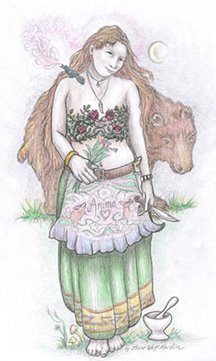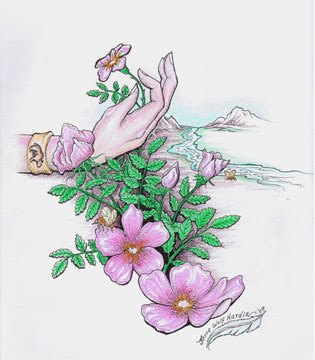
Living the Southwest means you get injured a lot: volcanic rock, an extraordinarily diverse array of cacti, pokey plants like Yucca, Agave and Nolina and lots of venomous insects like scorpions and spiders makes for good experience in general injury aid. While these herbs are primarily local SW herbs, you’ll usually be able to find local equivalents wherever you live.
White Sage (Salvia apiana) -cold, dry- A powerful disinfectant and anti-inflamatory that seems to share Lavender's ability to take the pain out of wounds, papercuts, cuts and burns. Other odiferous sages will work too, but this one is my favorite so far. I've had great results treating old, inflamed and infected wounds with it. It has a rather amazing ability to reduce pain in a big way (combine with Cottonwood and Pine for best results). For run of the mill scrapes and cuts I use a salve, but for deep infections, puncture wounds or burns in danger of infection I always use the diluted tincture.
Monarda fistulosa var. menthaefolia -warm/cool, dry- Wonderful for burns and any hot, irritated skin condition, rashes or wounds. I recommend using a fomentation or diluted tincture. I do expect that most Monardas would behave in the same way, but as I haven’t tried them, I can't be sure.
Mugwort (Artemisia spp.)-cool,dry- Great for itchy, hot rashes, the very best thing I’ve ever used on poison ivy and contact dermatitis conditions. Also makes a lovely (but terribly bitter) spit poultice for an array of wounds, rashes and other injuries. I’ve used it with very good results on tendonitis, sore muscles and contusions.
Yarrow (Achillea spp.) -cool/warm, dry- Yarrow is such a familiar wound herb I almost feel silly talking about it, but seeing as it’s one of my very favorites I must babble on a bit about it. Great for both deep and shallow wounds, very disinfectant, hemostatic and pain relieving. The roots are perhaps even more powerful than the flowering tops and preferable in the severe pain of toothaches. Spit poultices are phenomenal for insect stings and bites, but it works MUCH better if you add your spit than if you just smush the herb. Tincture & powdered flowering tops are my preferred preparations though I’ve had good luck with the vinegar as well.
Rose (Rose spp.) petal, leaf, bark or root -cold, dry- Excellent for blisters, burns, wounds and sunburns. Rose is a wound medicine of primary importance for many Native tribes. Diluted Rose petal vinegar is a wonderfully soothing way to treat a sunburn, takes the heat out quick. And Rose petal pastilles work great for a sore throat, Rose petal honey is wonderful, perhaps unsurpassed for burn care (I like it combined with Sage honey). Some indigenous people used branch/root ashes for burns too. You can pack wounds with ground Rose leaf and twigs, and fresh rose petals make a handy (and elegant) backwoods bandage (just lick it to make it stick better). And because Rose is such an efficient blood mover, I like to use a fomentation or vinegar on both small bruises and larger contusions, it can be combined with Peony root for even better results. And Rose leaf spit poultices are another great one for insect stings and bites.
Nettles (Urtica dioica) -cool, dry- A lovely and effective hemostatic, do be sure to use the ~dried~ leaves though. A salve made of the fresh plant is wonderful for eczema, psoriasis and other hot, dry rashes. It can also be used on strains, sprains and tendonitis. The fresh plant has been used as a counterirritant for arthritis but I haven’t tried that yet myself.
Comfrey (Symphytum officinale) -cool, moist- We've all heard about the amazing feats Comfrey has accomplished in the way of broken bones and wounds, but I was still quite shocked at the impressive results I obtained by using a simple Comfrey leaf salve on a knee ligament injury recently. The knee had been bashed in a truck door, severely bruising the ligaments and causing remarkable swelling with great pain and complete immobility. Now ideally, I would add something warming and diffusive to keep the injury from getting stuck and hard, but all I had on hand right then was a large container of comfrey leaf salve. Surprisingly, with each application the injury became noticeably less swollen and painful and eventually mobile. Through the healing process (the last month or so) I've tried various other herbs (liniments with lobelia and cayenne, arnica oil, Mugwort, Cottonwood, Mullein root and so on), the only things that came close were Cottonwood bud oil and Mugwort oil, but they still weren't quite as effective. Now most of you will already know this but I must mention it (no, I’m NOT going to talk about PLAs), but be sure not to use Comfrey on ANY open wound that might have even a TRACE of infection. It may cause the skin to heal so quickly that it closes right over a festering infection, leading to all kinds of systemic nastiness. This is a WONDERFUL herb used properly, but it’s powerful enough that we need to understand where it’s indicated and where it’s not.
Creosote Bush (Larrea tridentata) -cold, dry-
Great for scorpion stings, caterpillar hairs in your fingers (you know those little prickly haired caterpillars that crawl into bed with you and then leave their stingy hairs in your hands) and other venomous insects. A generally wonderful herb for all kinds of cuts, scratches, burns, wounds, fungal infections, rashes and just about anything else.
Goldenrod (Solidago spp) -warm, dry- An absolute miracle for pulled muscles, even when nothing else works. Better than ANY other herb I’ve ever used (including Arnica) for pulled, strained or overworked muscles. It works great for any wounds too, as well as arthritic swellings and the like, but it's specialty seems to be in the muscles. This is one of the twenty or so herbs I would NEVER be without, luckily it’s a very common weed in North America. I've used it primarily as an oil, but I suspect a liniment would be lovely too.
Pine (Pinus spp) -warm, dry- Pine resin makes an excellent if messy (ever tried getting melted pine resin out of the bottom of small mouthed quart jar? Impossible!)tincture vinegar or oil. The resin can also be used straight on wounds and burns. Anti-inflammatory, astringent and disinfectant, this is another very multi-purpose herb that can be used for just about any wound, nerve pain, burn, muscular aches or skin condition. Also great as a counterirritant to draw out splinters, boils an other things you don’t want in your flesh. And though I haven’t seen it confirmed in the literature, I find that it is often quite pain relieving. The needles and bark can be used as well but I like the resin best, for a milder preparation I mix all three together.
Cottonwood (Populus spp) -cool, dry- One of my very favorites, with many many applications. I make a vinegar with bark for burns, sunburns and scrapes. An oil of the buds is a great all purpose salve that relieves pain, disinfects and creates a protective coating over the wound. It also works remarkably well on contusions, tendonitis, injured ligaments, and strained or sore muscles. You can also use a high proof tincture of the buds and bark for any of those purposes.
Alder (Alnus spp.) -cool, dry- Astringent and anti-bacterial, Alder makes a wonderful salve, fomentation or liniment for sunburns, burns, all manner of wounds, infections and skin irritations.
Mullein root and flower (Verbascum thapsu) - A first rate herb for swellings, wounds, spinal injuries, bruises, burns, wounds and so on. The root and flower are especially anti-inflammatory though I find the leaves to be more directly healing. All parts of the plant are quite pain relieving.
Elder leaf, bark and flower (Sambucus nigra spp.) -cool, dry- Though a bit strange smelling, these Elder bits works very well for almost any inflammation, infection, rash, wound or pain. That sounds a bit broad, but Elder is one of the most multi-purpose plants I’ve ever worked with, energetically conforming to whatever need is present. I’ve used it for bruises, sprains, arthritis, nerve pain, cuts, infections, sunburns, severe burns and hot rashes all to good effect. I generally mix a little Elder into any wound preparation I’m making, just for good measure.
Mahonia spp -cold, dry- This lovely little berberene containing plant makes a great root powder for all kind of stubborn infections and various first aid needs. I find to work best in a mixed first aid powder containing other wound healing plants.
Plantain (Plantago major) -cool, neutral- The first plant to think of in venomous spider bites, especially those from the brown recluse, use poultices of the fresh plant. Extraordinarily healing and pain relieving for wounds, sprains, cuts, bruises, burns and insect bites and stings. The spit poultice works best, though oil based preparations are effective as well.
Prickly Pear (Opuntia spp.) pads and flowers -cool,moist- An excellent all around anti-inflammatory and wound healer. Of great use on stubbed toes, broken bones, burns or any other kind of swelling that you need to take the inflammation down on quickly. Just be sure not to hurt yourself worse with the stickers which are best burned off.
Vervain (Verbena spp.) -cool, dry- A specific for nerve & muscle pain, the powdered herb was traditionally used but the liniment seems to work very well too. It’s also quite useful for wounds, burns, eczema, sprains and insect stings and bites. For nerve pain, I recommend taking internally as well.
Snakeweed (Gutierrezia spp.)-warm, dry- A resinous and strange plant that populates huge sections of the West as a symptom of the overgrazing so prevalent here. Ranchers, gardeners and even the EPA seems to hate it, but Indigenous and Spanish peoples have long recognized it’s extraordinary value, and even considered to be sacred. The whole plant is very anti-inflammatory and pain relieving and has a long history of use in arthritis. Traditionally the dried plant was used in the bath and drank as a tea at the same time. It’s also effective made into an oil or salve and used on arthritic joints, sore muscles, and wounds. A poultice works very well for insect sting and bites as well as all manner of injuries, including sprains, broken bones and bruises.
Marshmallow, Mallow & Scarlet Globemallow (Althea spp., Malva spp. & Sphaeralcea spp.) -cool, moist- A very soothing demulcent plant, wonderful as a fomentation for burns, scrapes and rashes. Also as an all-purpose wound healer as it stimulates the immune system locally and allows the wound heal quicker. It’s also very drawing for splinters, boils and other things that need to come to the surface. I use as a fomentation, plaster or oil.
Usnea spp. -cool. dry- An intensely antibacterial lichen that can be powdered straight from the tree and used on any irritation, inflammation or infection. A high proof tincture is also effective. Decoctions will work but not all constituents are water soluble.
Cow Parsnip ( Heracleum maximum) seeds and root -warm, dry- A specific for nerve pain or injury and toothaches but useful for all wounds and swellings. I primarily use the diluted tincture.
Sunday, February 11, 2007
Choice Injury Herbs
Posted by
Oakmoss Changeling
at
1:53 PM
![]()
Labels: Medicine Woman Materia Medica, Therapeutics and Nutrition
Subscribe to:
Post Comments (Atom)
The Medicine Woman is glad you came...
All writings & posts (c)2007 Kiva Rose
All artwork & photographs (c) 2007 Jesse Wolf Hardin












No comments:
Post a Comment